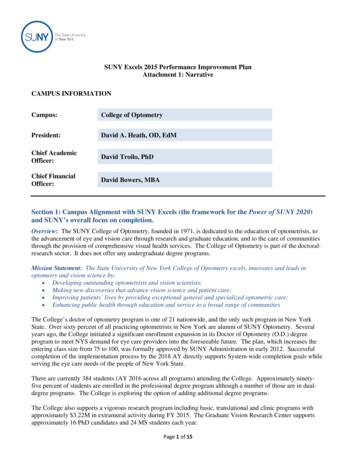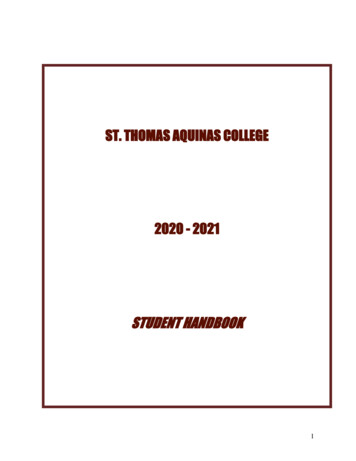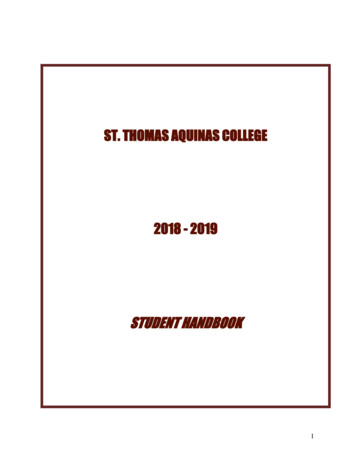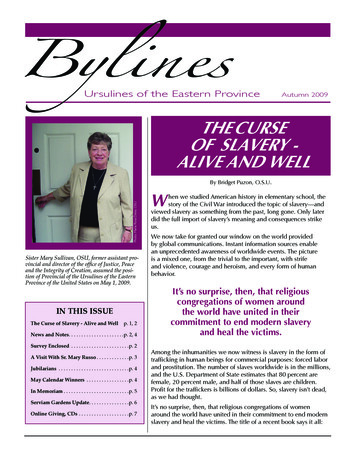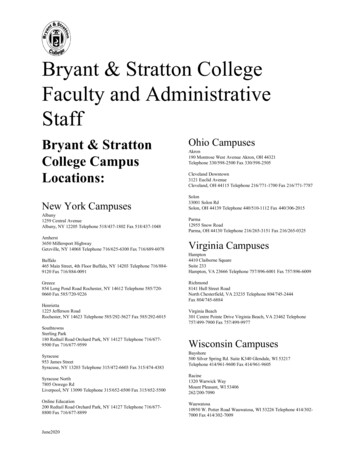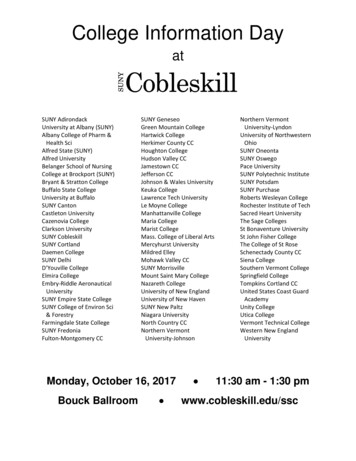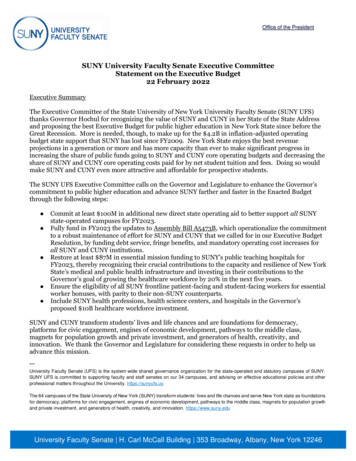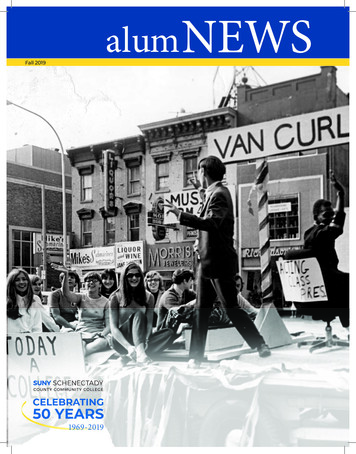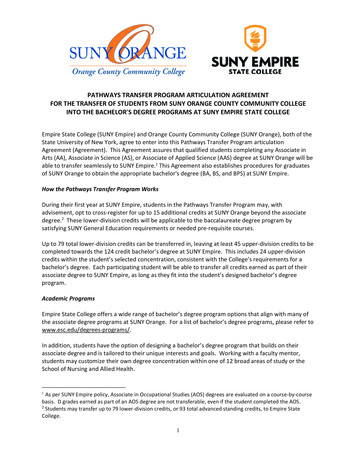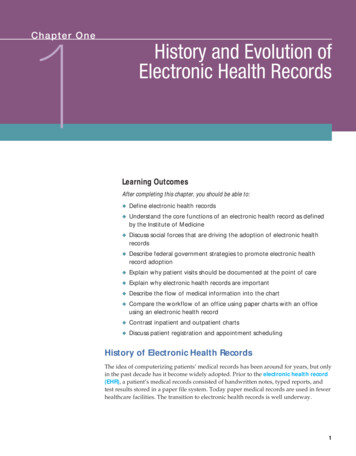
Transcription
SUNY Electronic Records GuidancePrepared by the SUNY Compliance Office and the Office of General CounselAt SUNY, the question of whether or not it is permissible to use electronicsignatures in lieu of hand-written signatures, and electronic (digital form) recordsin lieu of traditional paper records come up often. The issue is whether electronicrecords have the same legal force and effect of law, if hard-copy paper recordscan be converted into electronic format, and whether electronic signatures are aslegally binding as hand-written ones. This guidance sheds light on these issues inthe context of SUNY Policy and New York State laws and regulations.Electronic Signatures at SUNYAre Electronic Signatures Legal and Acceptable to use at SUNY?Yes, they are legal, but in accordance with applicable New York State regulation, each campus mustestablish a process for accepting electronic signatures to ensure their validity.What makes Electronic Signatures legal to accept and use in New York State?State Law Regarding Electronic SignaturesThe New York State Electronic Signatures and Records Act (ESRA) is the New York StateTechnology Law, Article 3, NY STT §§ 301-309, which authorizes the acceptance of electronicsignatures in most documents. It went into effect in August of 1999, and was updated in 2002to make New York State law consistent with the federal E-Sign law. The act provides that"signatures" made via electronic means will be as legally binding as hand-written signatures(meaning written and electronic signatures have the same validity), where statute defines an“electronic signature” as “an electronic sound, symbol, or process, attached to or logicallyassociated with an electronic record and executed or adopted by a person with the intent tosign the record.” The ESRA law and corresponding regulation apply to anyone using oraccepting electronic records and signatures in New York State. This law also formally says stateand local government entities can keep records electronically.Under the law, there are limited exceptions where electronic signatures are not consideredvalid. These exceptions are outlined in the following section of this document.SUNYElectronic Signatures and Electronic Records ConversionJanuary 20161 Page
Exceptions to Electronic Signatures in ESRA:There are a few notable exceptions to electronic signatures carved out in the law. An easy wayto remember is that the exceptions all involve death. Specifically, they are: Wills;Trusts;Decisions consenting to orders not to resuscitate; andPowers of attorney and health care proxies, with the exception of contractualbeneficiary designations.A note with regard to real estate:While generally negotiable instruments and other instruments of title are excluded from theprovisions of ESRA, those which are electronically created, stored or transferred in a specificmanner stipulated by ESRA are not excluded. As of September 23, 2012, ESRA allows the useand acceptance of electronic signatures and records with conveyances and other instrumentsrecordable under Article Nine of the Real Property Law, and permit recording officers toelectronically accept for recording or filing digitized paper documents or electronic records ofreal property instruments such as deeds, mortgages and notes, and accompanying documents.A note with regard to construction law:Pursuant to N.Y. General Construction Law § 46, a signature can be stamped if such stampedsignature is placed on a document “with intent to execute or authenticate” such document.Within § 46, the term “Signature” is defined as “any memorandum, mark or sign, erwiseplaced upon any instrument or writing with intent to execute or authenticate suchinstrument or writing.”What process must campuses establish to ensure the validity of electronicsignatures before they may accept them?SUNY Campuses must follow the New York Stater Regulations and establish aprocess to accept electronic signatures.In accordance with the ESRA Regulations, SUNY State-operated campuses cannot acceptelectronic signatures until they have outlined a process to ensure the validity of the electronicsignature. Under the NYS ESRA regulations §540.5(e), promulgated by the OFT (New York StateOffice of Technology Services), “Governmental entities using electronic records shall, in theabsence of specific statutory or regulatory requirements, have the authority to specify themanner and format in which electronic records will be received, produced, accepted, acquired,recorded, filed, transmitted, forwarded, acknowledged and stored. For the purposes ofensuring the receipt of electronic records, governmental entities must designate the receivingdevice.” The regulation also states in §540.5 (d) that “Governmental entities shall employprocedures and controls designed to ensure the authenticity, integrity, security and, whenappropriate, the confidentiality of electronic records.”SUNYElectronic Signatures and Electronic Records ConversionJanuary 20162 Page
The key requirement in the ESRA law and the Office of Information Technology Best PracticeGuidelines on the Electronic Signatures and Records Act: Governmental entities must conductand document a business analysis and risk assessment when electing to use or accept an esignature solution, where business analysis and risk assessment means identifying andevaluating various factors relevant to the selection of an electronic signature for use oracceptance in an electronic transaction.Such factors include, but are not limited to, relationships between parties to an electronictransaction, value of the transaction, risk of intrusion, risk of repudiation of an electronicsignature, risk of fraud, functionality and convenience, business necessity and the cost ofemploying a particular electronic signature process.” This document spells out the businessanalysis and risk assessment designed to meet the ESRA requirements outlined in theregulations.Under the NYS ESRA regulations §540.3(b), promulgated by the OFT (New York State Office ofTechnology Services), governmental entities can consult with CIO/OFT in its role as “ElectronicFacilitator” BEFORE defining additional standards for e-signatures and records to ensure thatsuch standards are consistent with ESRA.Additionally, from an internal controls and procurement perspective, electronic signatures areok if an agency has a process in place to validate that signature.Digitization of RecordsDo electronic records have the same legal force and effect as paper records?State Law Regarding Electronic RecordsThe New York State Electronic Signatures and Records Act (ESRA) is the New York StateTechnology Law, Article 3, NY STT §§ 301-309, and specifically the regulations that correspondto the act, §540.5 Electronic records, states that (a) An electronic record used by a person shallhave the same force and effect as those records not produced by electronic means. This lawalso formally says state and local government entities can keep records electronically.Do we have the authority to digitize records at SUNY?Yes, SUNY has the proper authority under the SUNY Records Retention Policy Doc. No. 6609 andcorresponding records schedules in the appendices to convert paper records into electronic format,and destroy the paper, so long as the electronic record is an accurate representation of theoriginal. This authority was approved by OSC, the AG’s Office, and State Archives, and is based onthe authority granted to us in State law, specifically the NYS Arts and Cultural Affairs Law Section57.05 and the Commissioner’s Regulations 8 NYCRR Part 188, where we derive the authority to haveour SUNY Records Retention Policy.The SUNY Records Retention Policy Doc. No. 6609 affords SUNY campuses permission to digitize allrecords, with very limited exceptions. These exceptions are noted directly on the SUNY recordsSUNYElectronic Signatures and Electronic Records ConversionJanuary 20163 Page
schedule that corresponds to the type of record classification. If the SUNY Policy schedule item doesnot have a specific notation that paper records must be retained, then SUNY campuses can digitizeand destroy the paper files. Since the SUNY policy has been approved by the Office of the StateComptroller and State Archives, we do not require pre-approval to digitize records (all other stateagencies must get pre-approval from State Archives before digitization). If a SUNY campus decidesto digitize records, they should not retain the original records. Instead, they should digitize therecords, ensure the electronic records meet the criteria listed in the SUNY Policy regardingelectronic conversion, and then dispose of the originals in a safe manner.As such, even if an agency were to come in after the fact and ask for the original paper copies, wecannot and should not be punished for producing electronic records instead, or printed our copiesof the electronic record stored into the system we are using for retention. Even with this oversight,we have been granted the authority to digitize our own records as we deem appropriate (with a fewLIMITED exceptions).Requirements for Digitization:The SUNY Records Retention Policy Doc. No. 6609’s Introduction section (available in theappendices) states the following regarding Electronic Conversion:“Periodically, campuses or the System Administration may decide to replace official records inpaper with electronic or digital copies. Most records in the SUNY Schedule have been preauthorized for replacement in the SUNY Records Retention Schedule such that paper recordswhich have been scanned or otherwise converted may be destroyed prior to the end of theirretention period. If not pre-authorized, replacement and destruction of paper records can occuronly upon approval by State Archives. Such approval requests shall be made by the SUNY RecordsManagement Officer upon request of the campus concerned. Campuses intending to replacepaper records with electronic or imaged copies are required to ensure that:(1) the images will accurately and completely reproduce all the information in therecords being imaged;(2) the imaged records will not be rendered unusable due to changing or proprietarytechnology before their retention and preservation requirements are met;(3) the imaging system will not permit additions, deletions, or changes to the imageswithout leaving a record of such additions, deletions, or changes; and(4) designees of the State University of New York will be able to authenticate the imagedrecords by competent testimony or affidavit which shall include the manner or methodby which tampering or degradation of the reproduction is prevented.”Campuses that are planning to digitize need to have a plan in place to ensure that the documentsare kept electronically in a file format that will remain accessible overtime (think VHS tapes or tapeplayers in today’s age – it is hard to get the content off of a VHS tape or a tape, without the VCR orthe 1980’s boom box and stereo). Whatever format the campus uses, they need to be sure that theformat will be good long-term, or have a plan in place for if the file format ever becomes obsolete.SUNYElectronic Signatures and Electronic Records ConversionJanuary 20164 Page
Campuses should work with their IT departments when considering digitization to ensure proper fileformats, and also that the campus has adequate electronic server storage space to handle theelectronic data.As of the creation of this publication, New York State Archives has said that the following formatsare a best practice for digitization of records: PDF/A ("a" referring to the archival format) is the preferred format for textual documents orhybrid documents with text and images. Tagged Image File Format (TIFF), is preferred for photographic records.Can campuses digitize and keep the paper copies also?Campuses that take the time to digitize their records should get rid of the duplicate paper copy assoon as possible, so long as the digital copy of the record meets the requirements of SUNY RecordsRetention Policy, and so long as the paper copies would not somehow be considered as historicaldocuments. The SUNY Policy requires that the electronically converted record have met fourelements: it is an accurate representation of original paper record, it is in usable format (usually.PDF), the records cannot be changed once converted, and they can be authenticated by employees.If the digital image meets the SUNY policy criteria, then the paper copy should be disposed of.When campuses decide to digitize your records, but retain the original paper copies, they areincreasing their burden administratively because they have doubled the amount of records they willneed to sort through and hold if they receive an information request or litigation hold, and they nowhave the burden to maintain two sets of records. Additionally, two sets of records leads toconfusion about which set can be relied on for the latest information. Additionally, two sets ofrecords creates more risk for a breach of the information, since it is stored in two mediums, andduplicate files also increases storage and server costs.A campus should ask themselves, what is the point of electronically scanning our records if we aregoing to retain the paper copies? The goal of electronic conversion is to simply your recordsmanagement process and to make the campus more time efficient at locating and maintainingrecords; it is not to double the amount of records that must be maintained, reviewed, stored, andprotected from security breaches.Bottom Line: If you take the time to convert your records into electronic format, so long as theelectronic copies meet the criteria under the SUNY policy, campuses should destroy the duplicatepaper copies.Are there local campus policies on digitization?It is very possible that campuses have their own local policies about what they require forcertain documents being in paper format. Specifically, this question has come up in the contextof Official transcripts in paper format, and transcript authentication (such as the original with aseal in paper format). Any local policy that a campus has requiring that certain documents beSUNYElectronic Signatures and Electronic Records ConversionJanuary 20165 Page
kept in their paper format would be more than is required by the law and SUNY System-widepolicy.Electronic Signature and Digitization ResourcesLawNY STT §§ 301-309 Electronic Signatures and Records ActNY STATE TECH § 301. Short titleNY STATE TECH § 302. DefinitionsNY STATE TECH § 303. Electronic facilitatorNY STATE TECH § 304. Use of electronic signaturesNY STATE TECH § 305. Use of electronic recordsNY STATE TECH § 306. Admissibility into evidenceNY STATE TECH § 307. ExceptionsNY STATE TECH § 308. Personal privacy protectionNY STATE TECH § 309. Use of electronic records and signatures to be voluntaryRegulation:Title 9 NYCRR Part 540s 540.1 Purpose, intent and applicability.s 540.2 Definitions.s 540.3 Electronic facilitator.s 540.4 Electronic signatures.s 540.5 Electronic records.s 540.6 Privacy and confidentiality.s 540.7 Electronic recording of instruments affecting real property.Supplemental Materials:2013 Best Practice Guideline, Electronic Signatures and Records Act (ESRA) Guidelines,document prepared by ITS, available ments/nys-g04-001.pdf].SUNYElectronic Signatures and Electronic Records ConversionJanuary 20166 Page
"electronic signature" as "an electronic sound, symbol, or process, attached to or logically associated with an electronic record and executed or adopted by a person with the intent to sign the record." The ESRA law and corresponding regulation apply to anyone using or accepting electronic records and signatures in New York State.
